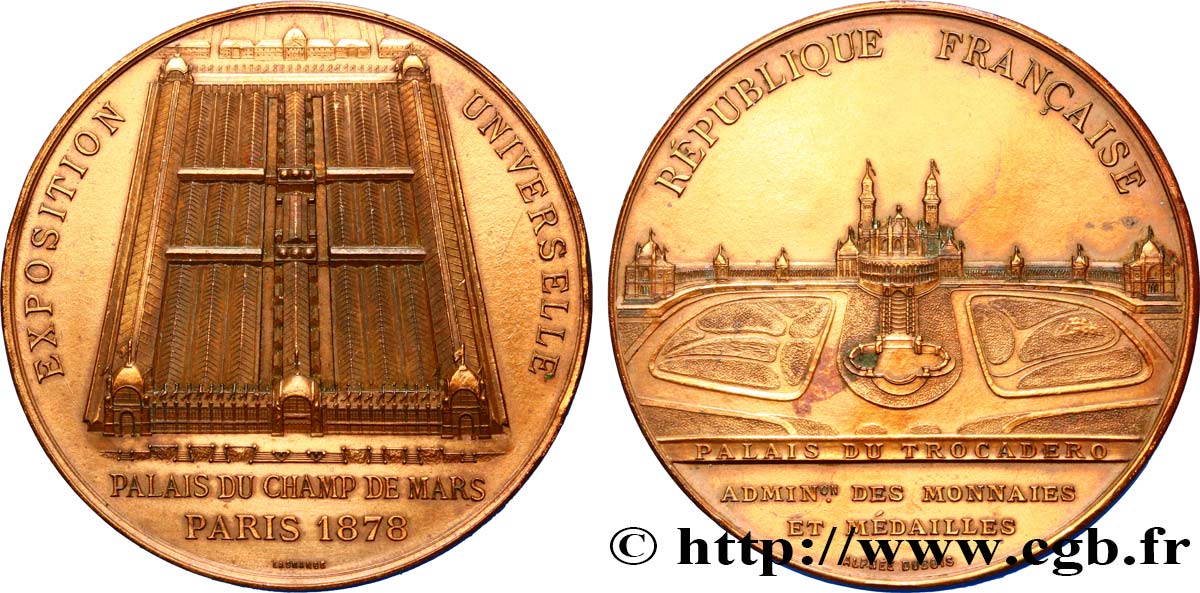fme_446980 - III REPUBLIC Médaille, Palais du Champ de Mars / Trocadéro
无库存.
所有在网站上销售的产品 (2018)
价格 : 100.00 €
所有在网站上销售的产品 (2018)
价格 : 100.00 €
种类 Médaille, Palais du Champ de Mars / Trocadéro
日期: 1878
铸币厂名称/城市 75 - Paris
材质 bronze
直径 46,15 mm
模子方针 12 h.
硬币制模工 LAGRANGE Jean (1831-1908) / DUBOIS Alphée (1831-1905)
重量 60,65 g.
侧面 lisse + abeille BRONZE
关于品相的说明
Médaille intéressante, mais nettoyée anciennement
正面
正面的文字 EXPOSITION UNIVERSELLE // PALAIS DU CHAMP DE MARS / PARIS 1878.
正面的说明书 Vue du Palais du champs de Mars.
背面
背面的文字 REPUBLIQUE FRANCAISE/ PALAIS DU TROCADERO/ADMINISTRATION DES MONNAIES/ET MEDAILLES.
背面的说明书 Vue du palais du Trocadéro, avec ses escaliers monumentaux et ses jardins.
评论
Médaille signée Lagrange au droit et Alphée Dubois au revers.
Le palais du Trocadéro était une construction de la seconde moitié du XIXe siècle de tendance éclectique, d'inspirations mauresque et néo-byzantine situé dans le 16e arrondissement de Paris, sur la colline de Chaillot, entre la place du Trocadéro et les jardins du même nom. Il était composé d'une salle de spectacle de 4 600 places prolongée de chaque côté par deux ailes courbées, accueillant chacune un musée (le musée des Monuments français et le musée d'ethnographie) et des salles de conférences.
Construit à l'occasion de l'exposition universelle de 1878, il n'était pas destiné à survivre à l'événement ; si le bâtiment est finalement conservé pendant une soixantaine d'années, il est l'objet de nombreuses critiques concernant son style architectural, son progressif délabrement et la mauvaise acoustique de la grande salle, rapidement désertée par les orchestres. Il est démantelé en 1935 pour l'exposition spécialisée de 1937, afin de laisser la place à une nouvelle construction, le palais de Chaillot.
Le palais du Trocadéro était une construction de la seconde moitié du XIXe siècle de tendance éclectique, d'inspirations mauresque et néo-byzantine situé dans le 16e arrondissement de Paris, sur la colline de Chaillot, entre la place du Trocadéro et les jardins du même nom. Il était composé d'une salle de spectacle de 4 600 places prolongée de chaque côté par deux ailes courbées, accueillant chacune un musée (le musée des Monuments français et le musée d'ethnographie) et des salles de conférences.
Construit à l'occasion de l'exposition universelle de 1878, il n'était pas destiné à survivre à l'événement ; si le bâtiment est finalement conservé pendant une soixantaine d'années, il est l'objet de nombreuses critiques concernant son style architectural, son progressif délabrement et la mauvaise acoustique de la grande salle, rapidement désertée par les orchestres. Il est démantelé en 1935 pour l'exposition spécialisée de 1937, afin de laisser la place à une nouvelle construction, le palais de Chaillot.








 对产品描述纠错
对产品描述纠错 打印
打印 分享我的选择
分享我的选择 提问
提问 Consign / sell
Consign / sell
 产品介绍
产品介绍









